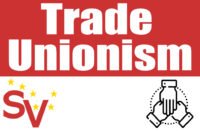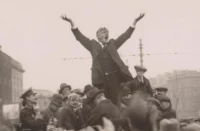A recent article in Socialist Voice made a powerful case for addressing the inequities of the Industrial Relations Act 1990. As the article identifies, the Act is an anti-union measure. Indeed, it might be said that Bertie Ahern achieved in one act what it took Thatcher and Major to do in several. The Act is restrictive, damages trade union autonomy and weakens the ability of workers to disrupt employers. Although not intended to contradict the view outlined in the original article that a repeal campaign is necessary, this author would propose that the benefits to such a campaign would be meagre and that we should probably look elsewhere on the question of union rights.
To consider this, take trade union density in the Irish economy. In 1994, union density stood at 45.8% but by 2003 this rate had fallen to less than 38% and continued to decline to under 28% in 2014. At the beginning of the recent recession in 2007 the figure was 32%. The recession prompted a recovery in union density and by 2010 it was at 33% (likely driven by collapsing numbers of employed). Since 2011, density has fallen from 33% to less than 28% in 2014. In the capitalist sector of the economy, union density declined at a steady pace from 27.1% to 16.6% between 2004 and 2014. Conversely, the share of public sector workers rose from 40% to 55% of all union members between 2004 and 2014, itself driven by falling employment numbers in that sector.
So, in real terms, we are talking about a minority of workers in the Irish economy who have the potential immunity to take a strike action in the first instance. This is not an insignificant point and one to which I will return to below.
Now consider strike frequency. The period 2010-2014 saw a yearly average of 10 strikes in the economy. In the period 2005-2009, there were 15, while between 2000-2004 – the boom years when we would expect strikes to be high given their pro-cyclical nature – there was a paltry annual rate of 25.¹ Usually these strikes occurred in the state and semi-state sector, not in the capitalist sector of the economy.
So not only are we talking about a sectorally-specific minority of workers who tend to dominate strike statistics, but even here the appetite of these workers to engage in strike action appears to be limited and declining.
Given such figures, it is debatable how much priority we should give to a campaign to reform the law around strikes when such action is infrequent and confined to minority groups of workers in specific sectors.
Of course, it could be maintained that the 1990 Act contributed to such a decline, but it is impossible to isolate the precise weighting of the law relative to other institutional, structural and ideological factors. It is likely that the law has played a minor role. In countries where industrial action is, in relative terms, weakly regulated by the law (e.g France), a decline in strike trends has also occurred in recent decades. Indeed, strikes are down everywhere in advanced capitalism. The primary driver is probably structural change in capitalist labour markets a consequence of the changing accumulation strategies of capitalists. This restructuring of capitalist accumulation has seen a decline in or hollowing out of traditional strike-prone, highly unionised industries e.g. manufacturing. Technological change has also played a role (think containerisation in the docking industry). The law is likely performing, at best, secondary effects on strike trends. This is further in evidence by looking at those sectors of the economy sheltered from the direct effects of changing accumulation strategies e.g. the public or semi-state sector. Such sheltering has upheld, in relative terms, a greater capacity to take strike action and so naturally enough this is where we find strikes.
Furthermore, the dangers of the 1990 Act, while real, can be overstated. Take for example the issue of secret ballots. Secret ballots have been a long part of the internal affairs of unions, but where workplace union organisation is relatively strong, the obligation to hold a ballot before taking industrial action can work to a union’s advantage. A large vote in favour can be used to exert pressure on employers to grant concessions in situations where the union is confident they have the support of the workforce. Shrewd union officials can use ballots to strengthen their bargaining power in negotiations, meaning that workers do not run the risk of going on strike action and losing pay.
Securing bargaining outcomes without recourse to strike action could be read as a gain for workers, although Marxists might want to calculate whether the loss of pay is made up for possible gains in class consciousness that the strike action might possibly engender (although admittedly the latter is more intangible and likely to be an indefensible position when presented as such to the mass of union members themselves). The problem may not be so much secret ballots, but the form they take i.e. postal rather than digital. A good turnout on a secret ballot is probably a more reliable indicator that members have the willpower to strike, then in circumstances of an ‘old school’ mass show of hands, where the force of peer pressure induces the appearance of support but perhaps not the internal commitment.
While the Act offers employers ample opportunities to frustrate action and, through Court orders, impose severe financial penalties on unions where its statutes are not observed, this is not very common employer practice. Sure, there are individual cases among a minority of hard-nut employers, but most are generally reluctant to involve the law because it inflames the dispute further, making it more difficult to resolve, damages the necessary goodwill when the return to production occurs and probably also damages their public image. Take for example the issue of sit-ins as raised in the original article. Of the number that did occur in post-crisis Ireland many played out without employers relying on the law (Vita Cortex, Waterford Crystal, Four Homes, Carnmore Airport for example; although Thomas Cook versus TSSA was a notable exception). Public support for the just cause of the workers in many instances, if not all, tended to weaken employer resolve to turn to the courts.
One real issue raised by the Act and indicated in the article is that workers in precarious work (if-and-when contracts for example) would struggle to take industrial action given their contractual position. Yet this is a non-problem for insignificant numbers of workers. Although the measures are imperfect, one estimate puts the number of workers on variable hour type contracts at about 5% of the working population.² Arguably if we are concerned with precarious workers, the right to strike is not one of their overriding priorities. In fact, the likelihood is that these workers are not even members of unions in the first place so the question of strike action is a non-starter. The more important question is how will these workers be organised? To talk about taking strike action in this context or to rely on unrepresentative single cases is to jump the gun on the matter.
We might also consider the prevailing level of class consciousness among the Irish working class in assessing the merits of a repeal campaign. Consider the relative ease at which elite groups have been able to divide Irish workers between public and private during the economic crisis. Consider then how a campaign to repeal the Act would playout in this context. One suspects divisive consequences because hostile forces will claim that in real terms such a campaign is simply a charter for already well-organised, ‘cossetted’ public or semi-state workers to cause further disruption to public services. While the ultra-left may make a fetish of strike action, going on strike is not palatable to most workers given the costs it engenders. It is questionable whether a campaign to make strikes easier is really going to appeal to significant sections of what is really a poorly organised working class with weak levels of class consciousness.
In conclusion, I would suggest that what left forces should first seek to achieve in the field of industrial relations is the building up of workplace organisation and trade union consciousness in the capitalist sector of the economy (while maintaining the relatively strong levels that exist in the public and semi-state sector). Rather than the issue of strikes and the 1990 Act being the campaigning issue we need to consider, the barriers to effective workplace organisation as presented by the Industrial Relations Amendment Acts of 2001-2015 should be seen as of greater contemporary concern. As such we need to tackle the issue of union density decline and collective organisation at the point of production rather than the issue of strike action. Of course, studies show that increases in strike action do increase membership and organisation,³ but given most strike action in Ireland occurs in the public sector, this effect is likely to have marginal effects in the private sector, the sector where the build-up of organisation is urgent.
The right to organise, the right to access workplaces and the right to recognition for collective bargaining is a more viable platform for the left to campaign upon. Given the trajectory of the current Industrial Relations Amendment Acts 2001-2015, which some sections of the union movement appear to have lost fate in as a means to organise non-union firms, the issue of workplace union recognition is likely to become an increasingly pressing one in the next few years (particularly if Sinn Fein join government and a constitutional campaign to give recognition rights is pursued, as would seem likely). A campaign around rights to organise, access or recognition on an ideological level would also be attractive as it can be marketed as giving workers positive rights of workplace empowerment presently denied in practice. With the correct marketing and public positioning (which unions could improve upon), this might present a real opportunity. The left then should begin to think about challenging the terrain on which the current Industrial Relations Act 2001-2015 functions. Let us worry about the 1990 Act when we have the industrial organisation and muscle to do so, but first let us build up membership through securing greater recognition of unions in the workplace.
- Source: Central Statistics Office.
- O’Sullivan et al. (2015) A Study on the Prevalence of Zero Hour Contract among Irish Employers and their Impact on Irish Employees.
- Hodder, A. et al. (2017) Does strike action stimulate trade union membership growth? British Journal of Industrial Relations, 55(1).






